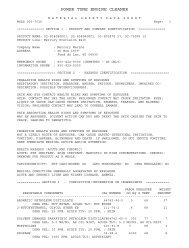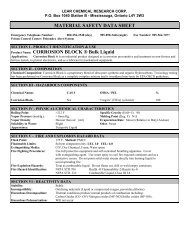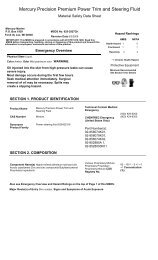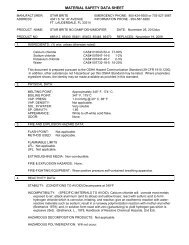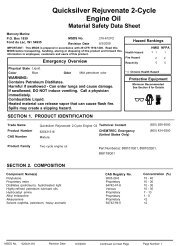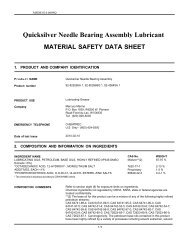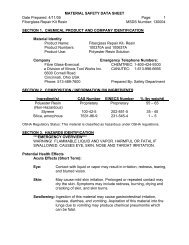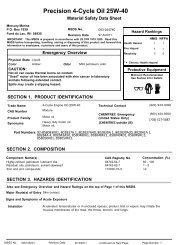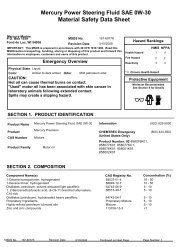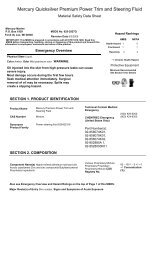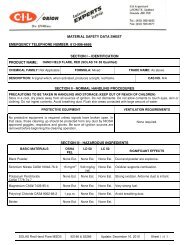TC-W3 Premium 2-Cycle Outboard Oil - Mercury Marine
TC-W3 Premium 2-Cycle Outboard Oil - Mercury Marine
TC-W3 Premium 2-Cycle Outboard Oil - Mercury Marine
Create successful ePaper yourself
Turn your PDF publications into a flip-book with our unique Google optimized e-Paper software.
QUICKSILVER - <strong>Marine</strong> Parts & Accessories <strong>Mercury</strong> <strong>Marine</strong> MSDS 090-6072C<br />
Product: Quicksilver <strong>TC</strong>-<strong>W3</strong> <strong>Premium</strong> 2-<strong>Cycle</strong> <strong>Outboard</strong> <strong>Oil</strong> (Canadian Product)<br />
Product #: 92-883660A 2, 92-883684A 1, 92-883685A 1, 92-883686A 1, 92-883687A 1<br />
SECTION I - MANUFACTURER INFORMATION<br />
Name: Shrader Canada Ltd. Emergency: 613-996-6666 (Canutec)<br />
Address: 830 Progress Court Information: 800-201-9486<br />
Oakville, Ontario Date Prepared: 06-10-02<br />
L6L 6K1<br />
Revised:<br />
SECTION II - HAZARDOUS INGREDIENTS/IDENTITY INFORMATION<br />
Hazardous Components* OSHA PEL ACGIH TLV Other % (Opt.)<br />
Ligroine (8032-32-4) N/D 300ppm 10-30<br />
Polybutene (9003-29-6) N/D N/AV 1-5<br />
*Specific Chemical Identity, Common Name (CAS)<br />
SECTION III - PHYSICAL/CHEMICAL CHARACTERISTICS<br />
Boiling Point: N/AV Specific Gravity (H 2 0=1): 0.86 @ 15°C<br />
Vapor Pressure (mmhg): 1 @ 20°C<br />
Melting Point: N/D<br />
Vapor Density (Air=1): N/AV<br />
Evaporation Rate: N/AV<br />
Solubility in Water: Insoluble<br />
(Butyl Acetate=1)<br />
Appearance and Odor: Blue liquid; petroleum odour HMIS Rating: H-1 F-2 R-0 P-Section VIII<br />
SECTION IV - FIRE AND EXPLOSION HAZARD DATA<br />
Flash Point (Method Used): 71°C (Method – N/D) NFPA Rating: N/D<br />
Flammable Limits: LEL – N/AV UEL - N/AV<br />
Extinguishing Media: Large Fires: Alcohol foam or water fog. Small Fires: Carbon dioxide or dry<br />
chemical.<br />
Special Fire Fighting Procedures: Use water spray to cool fire-exposed containers and prevent bursting.<br />
Do not use a direct stream of water.<br />
Unusual Fire and Explosion Hazards: Flammable when heated to temperatures above the flash point and<br />
on contact with an ignition source.<br />
SECTION V - REACTIVITY DATA<br />
Stability: Unstable ( ) Stable (X)<br />
Conditions to Avoid: Avoid excessive heat, sparks, and open flame.<br />
Incompatibility (Materials to Avoid): Avoid strong oxidizers such as HOOH (hydrogen peroxide), HN03<br />
(nitric acid), and oleum.<br />
Hazardous Decomposition or Byproducts: Carbon dioxide, carbon monoxide, and other unidentified<br />
organic compounds.<br />
Hazardous Polymerization: May Occur ( ) Will Not Occur (X)<br />
ADDITIONAL INFORMATION<br />
Distributed by: <strong>Mercury</strong> <strong>Marine</strong> Emergency: 905-567-6372 Ext. 4701<br />
2395 Meadowpine Blvd. Information: 905-567-6372 Ext. 4701<br />
Mississauga, Ontario, Canada
<strong>Mercury</strong> <strong>Marine</strong> MSDS 090-6072C<br />
SECTION VI - HEALTH HAZARD DATA<br />
Route(s) of Entry: Inhalation (Y) Skin (Y) Eye (Y) Ingestion (Y)<br />
Health Hazards (Acute and Chronic): Acute: N/D Chronic: Chronic overexposure to stoddard solvent<br />
and other aliphatic naphthas may cause damage to the central nervous system.<br />
Carcinogenicity: NTP (Not likely) IARC Monographs (Not likely) OSHA Regulated (Not likely)<br />
Signs and Symptoms of Exposure: Inhalation – No hazard under normal conditions of use. Inhalation of<br />
mists and vapours formed at high temperatures or on mixing may cause respiratory irritation. Skin –<br />
Prolonged or repeated contact can result in drying of the skin that can result in skin irritation and dermatitis<br />
(oil acne or rash). Eye – Direct contact cause eye irritation. Ingestion – No hazard in normal use. May have<br />
laxative effect.<br />
Medical Conditions Generally Aggravated by Exposure: N/D<br />
Emergency and First Aid Procedures: Inhalation – Remove victim to fresh air. Additional first aid is not<br />
normally required. Skin – Remove contaminated clothing. Wash affected skin with soap and water.<br />
Launder contaminated clothing before reuse. Eye – Immediately flush eyes with large amounts of water for<br />
at least 15 minutes, lifting upper and lower lids. Remove contact lenses if any after the initial flushing and<br />
then continue flushing. Ingestion – DO NOT INDUCE VOMITING! Give water if conscious. Get<br />
immediate medical attention.<br />
SECTION VII - PRECAUTIONS FOR SAFE HANDLING AND USE<br />
Steps to be Taken in Case Material is Released or Spilled: Wear suitable protective clothing. Follow<br />
applicable explosion and fire precautions during the response. Stop the spill at the source when safe to do<br />
so. Large Spills: Dike the area with a non-flammable absorbent material and collect adsorbate for<br />
disposal. Refer to the environmental ministry. Small Spills: Absorb residues with a non-flammable<br />
absorbent material and collect adsorbate for disposal.<br />
Waste Disposal Method: Reuse or recycling should be given priority over disposal under any<br />
circumstances. Do not dump unused contents into sewers, on the ground, or into any body of water.<br />
Destroy by incineration or biological treatment in accordance to applicable legislation.<br />
Precautions to be taken in Handling and Storing: Avoid excessive heat and the formation and inhalation<br />
of thermally generated mist or vapours. Keep containers tightly closed when not in use. Store in a cool area<br />
away from all sources of heat, ignition, and incompatibles.<br />
Other Precautions: KEEP AWAY FROM CHILDREN!<br />
SECTION VIII - CONTROL MEASURES<br />
Respiratory Protection (Specify Type): Not normally required. If TLV is exceeded, a NIOSH-approved<br />
respirator is advised.<br />
Ventilation: Local Exhaust & Mechanical: Sufficient mechanical ventilation to maintain exposure below<br />
the TLV. General mechanical ventilation is not recommended as the sole means of controlling exposure.<br />
Make-up air should always be supplied to balance air exhausted.<br />
Protective Gloves: Natural rubber<br />
Eye Protection: Safety glasses. Contact lenses should not be worn. They may contribute to the severity of<br />
the injury.<br />
Other Protective Clothing or Equipment: Sufficient clothing to prevent skin contact. Emergency<br />
showers and eyewash facilities should be nearby.<br />
Work/Hygiene Practices: Always follow good housekeeping and personal hygiene practices.<br />
N/D = NOT DETERMINED (NO DATA) N/E = NONE ESTABLISHED Y = YES<br />
N/A = NOT APPLICABLE N/AV = NOT AVAILABLE N = NO



